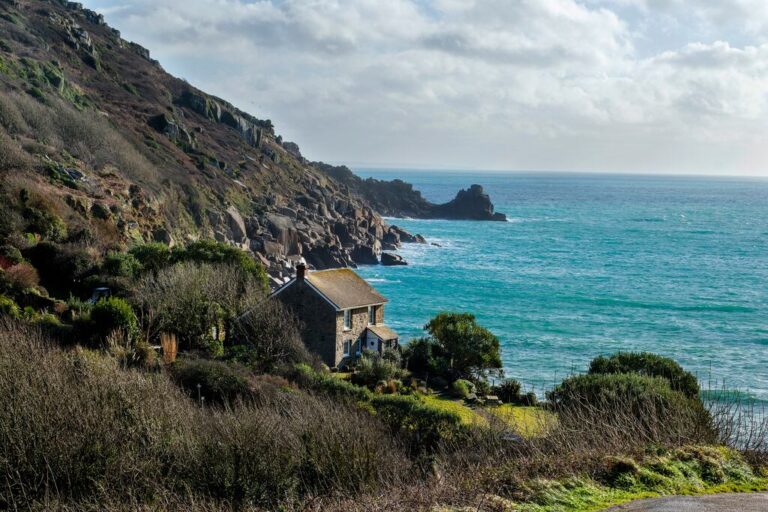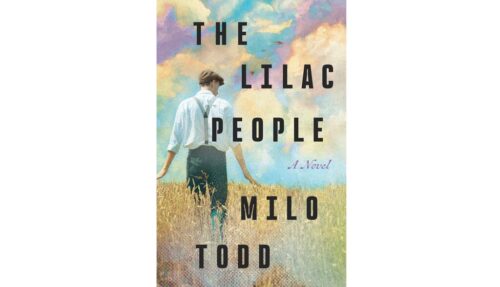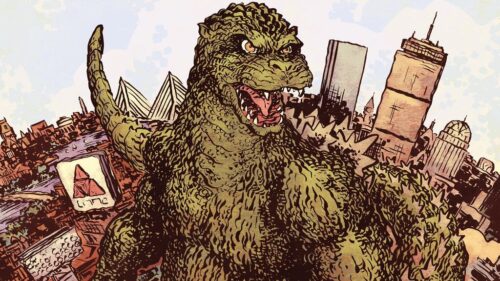It’s sunny as we touch down at London’s Heathrow Airport on a February morning. For my husband, Kim, and me, the clear skies are a sign that David John Moore Cornwell — better known by his pen name, John le Carré — is perhaps with us in spirit. This would be fitting, because a letter he wrote to us a decade ago will guide our journey to England’s southwest coast.
We are headed to Cornwall — the peninsula known for its rugged coastline and breathtaking views — where Cornwell lived for decades and wrote some of his most beloved spy novels. It’s also where, a decade before his passing in 2020, we had the honor to dine with him at his unpretentious house.
A journey to Cornwall is an enchanting addition to any trip to England and can easily be taken at the beginning, or end, of your stay. But there’s always an argument for an entire week in the area to more fully experience the views, history, food, and culture — the way Cornwell did.
A scenic train journey to Cornwall (from $69 as of mid-April; gwr.com) takes about five hours from Paddington Station in London to Penzance, where you can pick up a car rental. Call ahead for a pickup or take a short taxi ride to the car rental location, an Enterprise (+44 1736 332000).
Next, we make an overnight stop to visit friends in Dorset, home of England’s spectacular Jurassic Coast. After getting back on the road, we make our way to the lovely Cornish town of St Ives and stop at the Tate St Ives gallery (+44 1736 796226), a must-visit for anyone interested in contemporary art.
As we continue our drive, the rolling pastures, abundant cows, and beautiful villages let us know we’re getting closer to our destination.

When we visited in 2010, we stayed at a B&B near the historic artist enclave of Lamorna Cove. A handwritten letter from Cornwell had been delivered to our room earlier and was sitting on the fireplace mantel. His son, a friend of ours, had alerted him that we were going to be there.
Kim unfolded the letter and read it. Then he gave me a look. “David Cornwell has given us a list of his favorite places here!” The letter contained precious advice from the author: his favorite pubs, restaurants, and scenic walks. It also contained, to our amazement, directions on how to meet him for dinner at his house.
We knew Cornwell was not in the habit of inviting random tourists to his home for dinner. But we also knew that the former intelligence officer and author of Tinker, Tailor, Soldier, Spy and other classic spy thrillers had been a fan of Robert Newton, Kim’s father. Robert was a popular actor in the United States and Britain in the 1940s who had grown up in Lamorna Cove.
Thus, the special invite — and a chance to experience some of Cornwell’s favorite places.
Our accommodation this time is Birch Studio (from $393, seven night minimum), once the working studio of late painter Samuel John Lamorna Birch. It’s located in the same cove where landscape painter Algernon Newton, together with his wife, writer Marjorie, built a house called Bodriggy. The couple stayed there, with their four children, including Kim’s father, Robert, until about 1920.

Our cottage overlooks a babbling stream and woodland, where Birch once painted and fished for trout and where Kim’s father played as a child. Be warned that walking on the path down to the cottage is not easy for everyone. Other accommodation options in the area include Travelodge Hayle (from $70; +44 8719 846314).
The first place on Cornwell’s list is the historic Tolcarne Inn (+44 1736 363074), in Newlyn Harbor. He and his wife, Jane, used to enjoy their local fish and chips here. The place is now run by chef Ben Tunnicliffe. Fish and chips are no longer on the menu, although the freshest local catches and produce are. Booking ahead online is essential.
Kim enjoys the sea bass, with lemon glazed fennel, salsify, and dill cream sauce. I choose the vegetarian option, which is salt baked celeriac, broth, Swiss chard, and walnut ketchup with roasted onion. For food on the cheaper end, try Mackerel Sky Seafood Bar (+44 1736 366626), where we once gorged ourselves on beer-battered local white fish and crab salad.
Over whiskey, we reminisce about our feast back in 2010 with Cornwell. We started with smoked trout and champagne on his terrace overlooking the coast. Spotting a tourist boat passing below, I waved back joyfully to the passengers who waved up to their beloved author. David seemed to be amused by my antics but laughingly asked me not to encourage them.
Afterward, we went inside his home, once a collection of attached fishing cottages, where he lived with Jane. We talked with the author over the biggest, most beautifully cooked salmon we had ever seen. We had brought him a nice whiskey as a gift, yet discovered after dinner when we retired to his library, that his liquor cabinet contained an extensive whiskey collection.
Back in Lamorna Cove village, we stroll over to the local pub, the Lamorna Wink (+44 1736 731566). A caricature of Robert Newton in Treasure Island as Long John Silver, one of his most popular film roles, adorns the pub’s sign. Cornwell had told us he’d grown up watching Newton in films and admired his public persona. Seeing my father-in-law on the sign was the perfect end to our day.
Blessed by sunny weather on our second day in the area, we walk along a small portion of the South West Coast Path, a 630-mile coastal trail that starts in Somerset county and meanders through Cornwall, Devon, and Dorset before ending at Poole Harbour. The path was a part of everyday life for Cornwell, who was well-known for his daily jaunts.
We get off the path to view the Merry Maidens, an ancient monument near Lamorna Cove made of 19 standing stones. The stones seem magical and the site yields wonderful views of the surrounding countryside. Then we drive to the white sands of Porthcurno Beach to take in the spectacular view of the turquoise waters and wet-suited surfers.
That evening, not far from Cornwell’s house, we visit the Minack Theatre (+44 1736 810181), an open-air theater with summer operas, musicals, concerts, and plays. We have come for the sunset view off the magnificent cliffs here, but you can also book tours of the venue and visit an exhibition detailing the vision and labor of Rowena Cade, who designed the theater after helping put on a production of A Midsummer Night’s Dream at the site in 1929.
Our day ends at the Logan Rock Inn (+44 1736 810495), where we enjoy delicious pub fare. The landlady, Anita, reminds us how easy it is to utilize the local taxi to get from the pub to one’s accommodation. She tells us that Cornwell often used this service to get home from some of his longer walks.
The next morning, we venture to Penzance to visit Penlee House Gallery & Museum (+44 1736 363625), which holds some works of the Newlyn School painters, a colony of artists (including Lamorna Birch) who emerged in the area in the 1880s. We can’t resist having lunch at the museum’s Orangery Cafe — the broccoli stilton soup is sublime.
Afterward, we take a long walk on Marazion Beach, which overlooks St Michael’s Mount, an island with a medieval castle, village, and gardens (+44 1736 887822). You can take a boat to get here, or walk across a cobbled causeway during low tide.
The nearby Victoria Inn in Perranuthnoe (from $156 nightly, two night minimum; +44 1736 710309) is another of Cornwell’s recommended pubs. Kim has the fish and chips, and I have a fish pie; both are delicious. The management has changed since Cornwell frequented, but the inn retains its charm and offers bed and breakfast accommodations.
For those who like a leisurely stroll combined with shops and galleries, nearby Penzance has both. There are also many gardens to explore, including Trewidden Gardens (+44 01736 364275) with its 15 acres and cafe, as well as the Tremenheere Sculpture Gardens (+44 1736 448089). A type of giant rhubarb called gunnera cryptica, growing everywhere and now banned as an invasive species, makes you feel as if you are walking through a jungle. Despite this, it gets chilly here and is often windy, no matter the season.
The next morning we stop in Mousehole (pronounced “mowzul”), a picturesque fishing village that’s become a foodie paradise in recent years. We have breakfast at one of its trendy restaurants. It’s a different experience for us; we still remember Mousehole as an old-fashioned working fishing village. The beautifully presented breakfast is comforting and hearty.
On our final night, we stay at The Gurnard’s Head Inn (from $214; +44 1736 796928) near the village of Zennor. This pub was a favorite of the Cornwells before they passed away, he in December 2020 and she two months later, in 2021. The manager points out where the couple liked to sit, next to the fireplace.
Our stay here is the highlight of our visit. We take the bed and breakfast with dinner option and sink into the pub’s coziness. An old-fashioned transistor radio is playing in our room on arrival. The bathtubs are large, and the heated towel rack and comfy king bed make this even more welcoming after walking the coastal trail.
After a hearty English breakfast in a dining room with a close-up view of the chef at work, we walk toward a massive rocky headland, called Gurnard’s Head, where we see wild ponies grazing National Trust lands.
We walk part of Tinners’ Way, a path that Cornwell called his favorite route, past Tregerthen Cottage (where D. H. Lawrence once lived and wrote), past Wicca Farm, and then back down the coast path to Zennor. The path is circular, beginning and ending at The Tinners Arms, where you can get a traditional pub meal and a pint as a payoff for your efforts.
This southwest area of Cornwall is wild and beautiful, and sometimes, if you listen, you can hear the ghostly whispers of the artists who lived here long ago. Now there are soft whispers of David Cornwell, too.
We can only speculate how Cornwell sustained his creative brilliance. Perhaps it had something to do with the freedom of walking this land — and having a great pint of ale afterward. Our letter gives us clues about the life he led. It’s also a map for the region he loved — and something we can all cherish.
Writer Cheri Newton and photographer Kim Newton are based in Tucson. Send comments to magazine@globe.com.




Comment count: